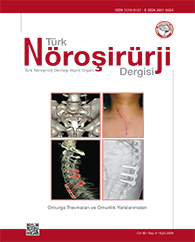Türk Nöroşirürji Dergisi
2020 , Vol 30 , Num 3
Evaluation of Cervicothoracic Junction Injury
1Atatürk Üniversitesi Tıp Fakültesi, Beyin ve Sinir Cerrahisi Anabilim Dalı, Erzurum, Türkiye2Serbest Hekim, Beyin ve Sinir Cerrahisi, İstanbul, Türkiye Cervicothoracic junction (CTJ) injuries account for about 10% of all cervical injuries. Conventional radiographs can easily be overlooked due to the difficulty of imaging the junction. Compression fractures, burst fractures, facet joint fractures, dislocation and ligamentous injuries can be seen in this region. It usually occurs due to motor vehicle and sports injuries and rarely due to penetrating injuries. The CTJ is a region prone to instability and deformity due to its anatomical and biomechanical properties. CT should be the first imaging tool to be preferred in the evaluation. MRI is used to evaluate the spinal cord, disc, ligament or other soft tissues. In these traumas, medical treatment, immobilization, physical therapy, bed rest are applied together. As in other parts of the spine, the purpose of surgical interventions in this area is to relieve the neural elements under pressure and to accelerate healing (decompression), to restore the spinal alignment that cannot be achieved by conservative and closed methods (internal reduction), to reconstruct the disrupted biomechanical balance and anatomical alignment (stabilization and correction), and to ensure that the patient can be returned to daily life as soon as possible (early rehabilitation). For this purpose, anterior, posterior and combined methods can be used. Anahtar Kelimeler : Cervicothoracic junction, Injury, Evaluation

